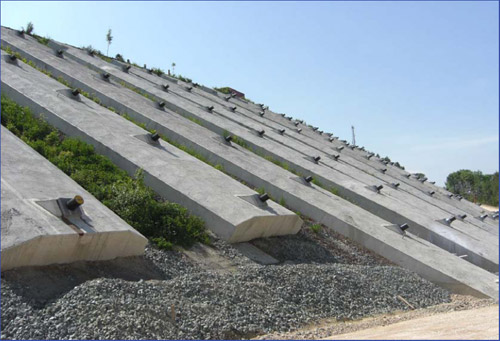Williams Anchors: The Preferred Choice for Critical Anchoring in Challenging Atmospheres
Williams Anchors: The Preferred Choice for Critical Anchoring in Challenging Atmospheres
Blog Article
Reliable Rock Anchors for Secure and Stable Foundations
In the realm of civil engineering, the function of reputable rock anchors can not be overemphasized, as they are critical in establishing safe and secure and steady structures across a range of applications. Understanding the different types of rock supports, their particular applications, and the intricacies of installment and upkeep is vital for maximizing their performance.
Sorts Of Rock Anchors

Easy supports depend on the weight of the framework and the surrounding dirt or rock to offer resistance. They are usually used in applications where minimal motion is expected. Active supports, on the other hand, include the application of stress via a high-strength wire or pole, developing a pre-stressed problem in the anchor. This kind is especially beneficial in dynamic atmospheres, such as landslide-prone locations.
Grouted anchors are an additional substantial classification, in which a steel bar or cord is placed right into a drilled opening, complied with by a cementitious grout. Once healed, the cement bonds with the bordering rock, producing a durable anchoring system. Each kind of rock anchor uses unique benefits based on the certain geological problems and structural needs, consequently playing a vital duty in the general honesty and long life of created facilities.
Applications in Building And Construction
Rock anchors play an essential duty in various building applications, offering vital assistance and stability in diverse atmospheres. These innovative services are utilized in projects ranging from massive facilities advancements to smaller sized property frameworks. One of the main applications of rock supports remains in the stablizing of slopes and keeping walls, where they assist protect against soil erosion and keep architectural integrity.
Additionally, rock anchors are important in protecting foundations for bridges, tunnels, and skyscraper buildings, guaranteeing they can stand up to lateral forces such as wind and seismic activity. Their flexibility enables for installation in challenging geological conditions, making them optimal for tasks in mountainous or rocky terrains.

Key Choice Criteria
Selecting the proper rock anchor for a certain application needs cautious factor to consider of a number of vital requirements. The geological conditions of the site have to be completely examined. Recognizing rock type, strength, and security is crucial to make sure that the anchor will perform successfully under load problems.

Another crucial aspect is the deterioration resistance of the anchor products. In atmospheres revealed to wetness or chemicals, using corrosion-resistant products will certainly lengthen the life expectancy of the anchors and preserve structural integrity with time.
In addition, the support's setup technique ought to line up with the project's needs and restraints. Relieve of installation, in addition to the potential influence on bordering structures, must be taken into consideration.
Installment Methods
Reliable installment strategies are essential for the successful performance of rock anchors. Proper setup ensures that the supports achieve the preferred load-bearing ability and security within the geological conditions. The initial action in the installation process involves website assessment, where geological studies determine the rock type, condition, and any type of possible challenges.
As soon as the website is assessed, the appropriate exploration method have to be picked-- choices include rotating boring, ruby drilling, or percussion boring. The choice relies on rock hardness and ecological considerations. Precise exploration deepness and angle are necessary to make sure that the supports align with architectural requirements and tons distribution.
After boring, the next phase involves cleansing the borehole to get rid of particles, which can compromise bond strength. Following this, the support is inserted, and if required, a cement or material is infused to enhance attachment. The treating time of these materials should be abided by, making certain that the anchors attain complete strength prior to any lots is used.
Upkeep and Evaluation
Proper maintenance and examination of rock supports are necessary to ensure their lasting performance and dependability (Williams Anchors). Regular analyses aid identify any prospective issues, such as deterioration, displacement, or architectural tiredness that might endanger the stability of the anchoring system
Regular evaluations should be conducted at specified intervals, considering environmental elements and the specific application of the rock anchors. Visual examinations must concentrate on the exposed areas of the anchors, looking for indications of rust, fractures, or other abnormalities. In addition, it is important to assess the surrounding geological conditions to detect any type of shifts in dirt or rock that might affect anchor performance.
In linked here many cases, advanced techniques such as load testing or non-destructive screening might be required to identify the supports' load-bearing ability and total wellness. Proper documentation of evaluation findings, maintenance activities, and any type of repair services or substitutes executed is crucial for ongoing examination and compliance with sector requirements.
Conclusion
Finally, reliable rock supports play a critical function in making sure safe and stable foundations throughout different construction applications. By properly moving lots and improving stability versus side pressures, these supports add considerably to the durability and stability of frameworks find out here such as bridges, tunnels, and maintaining walls. Strategic selection, installation, and upkeep of rock anchors Get the facts are necessary for enhancing performance and securing public safety and security, inevitably underscoring their significance in modern design practices.
Report this page